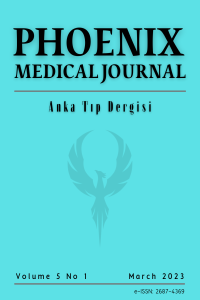Nonketotik Hiperglisemide Görüntüleme Bulguları
nonketotik hiperglisemi, kore, stroke taklitçileri, manyetik rezonans görüntüleme
Imaging Findings of Nonketotic Hyperglycemia
___
- Hegde AN, Mohan S, Lath N, Lim CCT. Differential Diagnosis for Bilateral Abnormalities of the Basal Ganglia and Thalamus. RadioGraphics, 2011;31(1): 5–30.
- Hansford BG, Albert D, Yang E. Classic neuroimaging findings of nonketotic hyperglycemia on computed tomography and magnetic resonance imaging with absence of typical movement disorder symptoms (hemichorea-hemiballism). Journey of Radiology case reports. 2013;7(8):1-9.
- Wintermark M, Fischbein NJ, Mukherjee P, Yuh EL, Dillon WP. Unilateral putaminal CT, MR, and diffusion abnormalities secondary to nonketotic hyperglycemia in the setting of acute neurologic symptoms mimicking stroke. AJNR Am J Neuroradiol. 2004;25(6):975-976.
- Shan DE, Ho DM, Chang C, Pan HC,Teng MM. Hemichorea-hemiballism: an explanation for MR signal changes. AJNR Am J Neuroradiol 1998;19:863-870.
- Yayın Aralığı: Yılda 3 Sayı
- Başlangıç: 2019
- Yayıncı: İbrahim İKİZCELİ
Acil Ambulans Hizmetleri Sağlık Çalışanlarında Öfke Durumu Değerlendirilmesi: Anket Çalışması
Onur YILMAZ, Afşın İPEKCİ, Yonca Senem AKDENİZ, Fatih ÇAKMAK, İbrahim İKİZCELİ
Nadir Bir Olgu: Herpes Simpleks Ensefaliti
Cansu KIZILTAŞ, Vildan ÖZER, Selman YENİOCAK, Abdulkadir GÜNDÜZ
Suna AVCI, Sayid ZUHUR, Nazan DEMİR
Acil Serviste Hasta ve Hasta Yakınlarına Karşı Şiddete Bir Bakış
Mustafa KATRAN, Yonca Senem AKDENİZ, Afşın İPEKCİ, İbrahim İKİZCELİ
Nonketotik Hiperglisemide Görüntüleme Bulguları
Ergül CİNDEMİR, Nurdan GOCGUN, Türkan İKİZCELİ, Behice Kaniye YILMAZ, Rüştü TURKAY
Sol Femoral Cisim Kırığı Olan Bir Hastada Sağ Patella Kırığı
Turker DEMIRTAKAN, Afşın İPEKCİ
Acil Serviste Hemodiyaliz Endikasyonu Konulan Hastaların Analizi
Melek AKTEPE, Yonca Senem AKDENİZ, Afşın İPEKCİ, Fatih ÇAKMAK, Mehmet Rıza ALTIPARMAK, İbrahim İKİZCELİ
Acil Serviste Yaralanmaların Demografik Analizi ve Niyetselliği
Bir Garip Kaza: Posterior Üretrasında İğne Olan Bir Çocuk
Yonca Senem AKDENİZ, Musa BALTA, Afşın İPEKCİ, İbrahim İKİZCELİ
